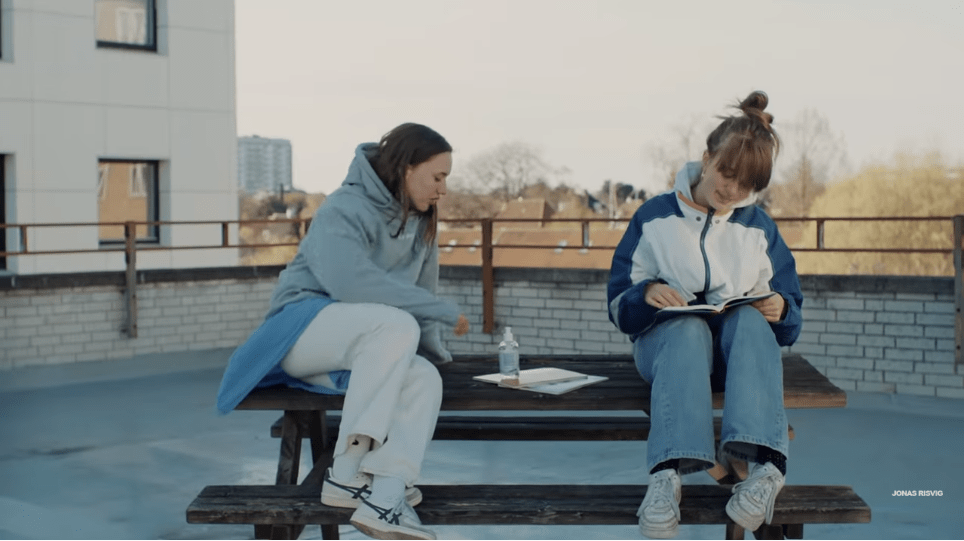While most Danish film and television production was halted because of COVID-19, Jonas Risvig’s web series CENTRUM, co-created with teenagers, has used the extreme moment in time to make two no-budget episodes a week about being young during a pandemic.
By Katrine Bouschinger Christensen and Eva Novrup Redvall
There’s not a lot of popular Danish fiction among Danish children and young audiences. While the DR Ultra channel, targeting 9-14-year-olds, does have popular series, the majority of the media diet of Danish teenagers is foreign content. When Denmark suddenly locked down because of COVID-19, this led to Danish director Jonas Risvig thinking that something had to be done. All of a sudden all school children were to spend a lot of time at home with a very limited output of Danish content to keep them company. He decided to, basically out of nowhere, create a series for them that would catch this unique moment in time and give them an outlet for sharing their thoughts, concerns and stories.

Fig. 1: How do you create a poster with the lead cast under social distancing rules? You photoshop three separate images. Photo credit: Courtesy of Christian Torp, Jonas Risvig and the CENTRUM team.
The resulting web series CENTRUM, focusing on the life of three ordinary 16-year-old teenagers Luna, Agnes and William in the Copenhagen suburb Valby, has turned out to be highly popular on YouTube, not the least because of the invitation for young people to take part in the writing of the series. When the RYA project interviewed Jonas Risvig, he told that 90% of the input for the series comes from them while the last 10% is him helping to dramatically structure their ideas. Moreover, the series also intends to inspire teenagers to create their own series, with all screenplays as well as camera and sound gear specifications being available online so that young people can see what they might need if they were to create their own series from scratch.
A no-budget dogma production
Jonas Risvig has previously created content for DR Ultra and has a number of professional productions in the pipeline. However, CENTRUM is a no-budget production, since this was needed to be able to just start shooting and catch this peculiar point in time. Everyone works for free and – coming from the land of ‘Dogma 95’ – the framework is based on a number of dogmas to keep things simple. An episode is built around three scenes with 2-3 actors in each scene. Everything is shot outdoors within a radius of one kilometer so that one can walk or bike to each location. Due to COVID-19 restrictions, the production has to respect social distancing. This is doable when the production team is limited to the three teenage leads, two photographers, two sound people, a producer and Risvig directing.

Fig. 2: CENTRUM has fostered an additional universe of content e.g. this music video ‘Ferrari’ (by Luna) which went viral on TikTok. Photo credit: Courtesy of Jonas Risvig and the CENTRUM team.
Risvig describes how his motivation for the series has been to illustrate what he compares to living ‘during a wartime’, emphasizing the historic elements of documenting life circumstances under COVID-19. Leaving the 9th grade, equivalent of leaving Secondary school in the UK, is a defining moment in time, but this spring and summer everything is cancelled. How does one deal with that? What does life among young people look like during a pandemic lockdown? To find out, he involved around 100 young people as part of a panel writing and providing input for the series, and the many users online are also continuously invited to contribute. There are surveys popping up during each CENTRUM episode where one can get a quick ‘yes’ or ‘no’ sense of what viewers think, and there’s also additional video material where the young actors present and discuss the many ideas submitted online. Accordingly, the series comes across as an invitation to interact and participate, and some of the extra material – such as music videos created by the team – has led to creative TikTok activity by fans.
Camoes as a catch
When starting up the series, a big question was how to get the young audience to watch. One strategy has been to insist on having sporadic humour in the series. CENTRUM is about a serious time and serious matters, but it has to be fun to watch. Moreover, Risvig decided to have a form of comic relief in each episode through a cameo by a well-known person in the world of young people. In the first episode it was Thor Farlov from the popular Danish pop duo Citiboys. In later episodes it has been the stand-up comedian Mick Øgendahl or Alex Høgh Andersen, the young Danish actor starring as ‘Ivar the Boneless’ in Vikings. The famous people take on a regular part in an episode, such as playing an older brother or a school teacher. They are often a tongue-in-cheek element in a universe that is otherwise only populated by the teenagers. And due to the pandemic, several renowned actors, comedians or musicians have had the time to commit and support the project.

Fig. 3: Jonas Risvig talking with Pilou Asbæk in a masterclass on acting. Photo credit: Courtesy of Jonas Risvig.
CENTRUM is located on Jonas Risvig’s YouTube channel which also contains ‘Digital+Social’ masterclasses targeting adolescents where Risvig interviews established actors or talents about their craft. As an example, one masterclass has Risvig talking to Danish actor Pilou Asbæk (from Game of Thrones) about his current international production being shut down because of COVID-19 and his way of approaching acting on many different levels. As the text accompanying the masterclass states, one might as well use the time spent at home during lockdown “constructively and creatively”. Sharing knowledge and tools for creating engaging fiction is one way of doing this based on the message: Stay at home and be creative.
A wake-up call for the industry
While the no-budget set-up of CENTRUM is not an example of an attractive business model for the industry, the series has already attracted attention and led to production companies and broadcasters checking in to hear if they could be involved. Risvig hopes that the series can be a wake-up call for an industry dominated by “white meeting rooms with men in suits” who always want ‘proof of concept’ before commissioning anything and for a TV landscape where strong fiction is needed to compete with the abundance of reality TV shows. He describes how he used to think that he needed a big budget to make anything. Now he argues that, basically, all you need is a camera and some friends.

Fig. 4: While most of the CENTRUM screenplays are shot more or less as written, there’s always some room left for improvisation, e.g. in this scene where Luna’s brother forgets his hand disinfectant dispenser resulting in an improvised small talk about hand sanitizer. Photo credit: Courtesy of Jonas Risvig and the CENTRUM team.
However, you have to accept the fact that producing in this way means working with what he describes as “80% intensity”. You can’t have a polished result. Shooting two episodes a week under the CENTRUM conditions calls for making fast decisions and letting material go even though you might want to correct certain things or details. The value in this is that the material has the mark of being authentic, intensive and current. Risvig argues that this makes it more relatable for young audiences than many other more ‘perfect’ productions.
You have to know that you don’t know anything
Asked about his three main pieces of advice in terms of creating content for children and young audiences, Risvig argues that first of all you have to realize that you don’t know anything and question everything. As an example, he used to think that young people called each other a lot, but they never do, therefore no one speaks on the phone in CENTRUM. Secondly, one has to remember that being young is not necessarily fun. Adults are often trying to make fun of young people or create something funny, but being 15 is being in the eye of a hurricane and one has to take that dead serious. Lastly, one has to be able to let go of one’s authority, try to ignore one’s ego and be ready to play ball with other people. Making television for children and young audiences is a team sport rather than an individual endeavor and one has to always keep that in mind.

Fig. 5: CENTRUM lets the teenagers share some of the very concrete consequences of COVID-19 in their lives, such as not being able to get a hug from your friend when you need it or sleeping over because of social distancing rules. Photo credit: Courtesy of Jonas Risvig and the CENTRUM team.
In terms of challenges related to production, Risvig describes the hardships of trying to communicate clearly to the intended 14-17-year-old audience that this series is made for them and not their parents. It’s a major problem that adults often pick up on new trends and invade the platforms for children and young audiences which the target audience definitely doesn’t appreciate. Just as SKAM turned out to have a much wider appeal than the intended 16-year-old girls, CENTRUM currently has a diverse audience on the YouTube channel. It’s a challenge to frame the series so that its main audience still feels that the series and its space is theirs.
This blog might not be helpful in this regard … but hopefully, as scholars rather than parents, we can justify disturbing the children and youth space and spying on successful content and new production strategies to see what can be learned, in the Danish context as well as in an international and comparative context.
Thank you to Jonas Risvig for finding the time to talk to the RYA project and reading this blog about CENTRUM in an incredibly busy time.
Katrine Bouschinger Christensen is PhD fellow in the Section of Film Studies and Creative Media Industries at the University of Copenhagen with a thesis on producing serial drama and online fiction for children and young audiences as part of the RYA research project.
Eva Novrup Redvall is Associate Professor at the University of Copenhagen where she is head of the Section for Film Studies and Creative Media Industries and principal investigator of the RYA research project.





